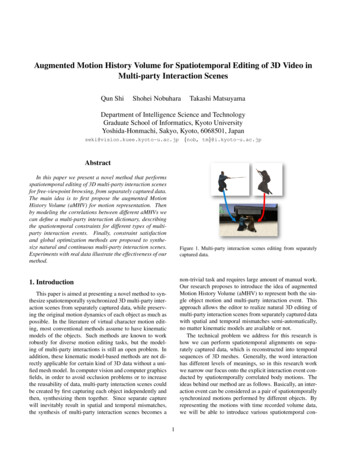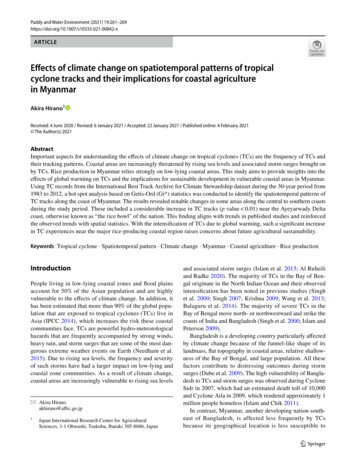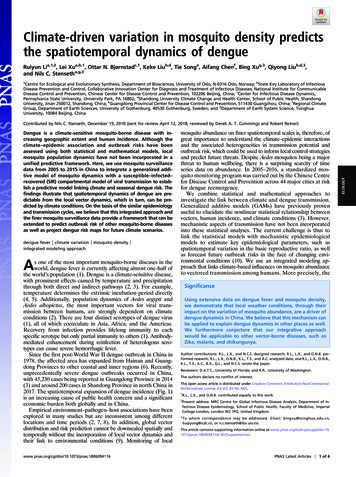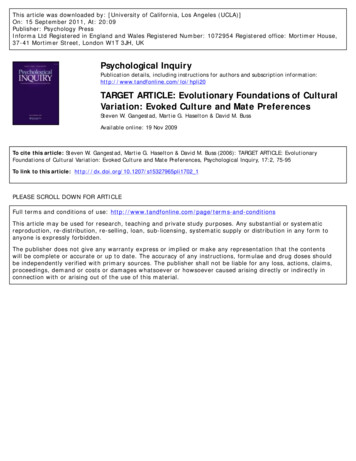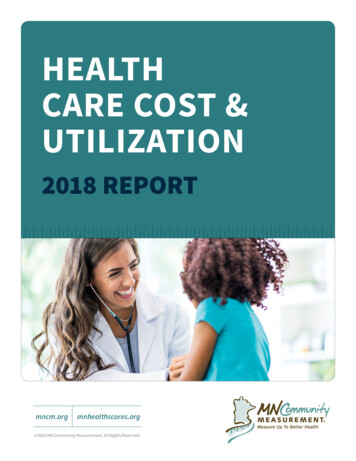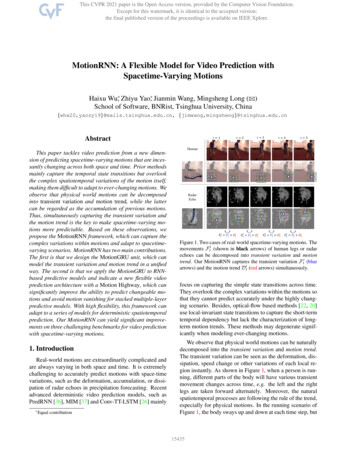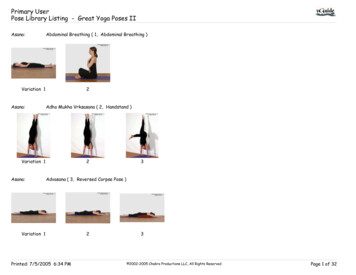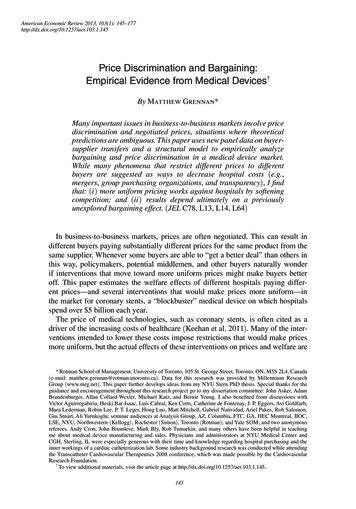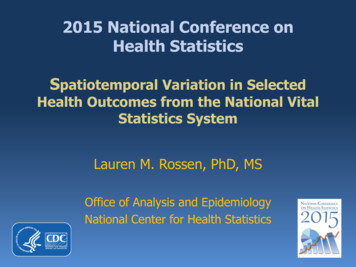
Transcription
2015 National Conference onHealth StatisticsSpatiotemporal Variation in SelectedHealth Outcomes from the National VitalStatistics SystemLauren M. Rossen, PhD, MSOffice of Analysis and EpidemiologyNational Center for Health Statistics
Acknowledgements:Co-authors:Diba KhanBrady HamiltonMargy WarnerColleagues in the Division of Vital Statistics,Office of Research Methodology, and theResearch Data CenterDISCLAIMER: The findings and conclusions in this report are those of the authors and donot necessarily represent the official position of the Centers for Disease Control andPrevention
Small Area Estimation Methods forSpatiotemporal SmoothingApplications:1. Drug Poisoning Death Rates in the U.S.,2002-2013 Two-stage hierarchical generalized linear models2. Teen Birth Rates in the U.S., 2003-2012 Hierarchical Bayesian space-time interactionmodels
First Example of SmoothingDrug Poisoning Mortality, 2002-2013
Drug Poisoning Mortality, 2002-2013BACKGROUNDDeath rates associated with drug poisoning have doubledsince 2000, to 14 per 100,000 in 2013 More deaths due to drug poisoning than motor vehicle crashesDrug overdoses are a major public health concern Death rates highest in West Virginia (32), Kentucky (24),New Mexico (23), Rhode Island (22) and Utah (22) Interest in county-level variation: Where are death rates due to drug poisoning highest or lowest?Where have we seen larger or smaller increases over time?
RATIONALE FOR SMOOTHING: Drug Poisoning Death rates with data suppressed for counties with 20 deaths in 2009 87% of counties suppressed! Rare outcomes cannot look at sub-state variation using directestimates
RATIONALE FOR SMOOTHING (continued) Rates are unstable for counties with small populations Could combine years, but would mask temporal trends
AN EXAMPLE OF UNSTABLE RATES Solid sand-colored line is a large city, other 4 counties are small Death rates fluctuate from 0 to 200 per 100,000 from year-to-year
DATA AND ANALYSES yit Age-adjusted death rate (AADR) fromdrug poisoning for county i at time t–from National Vital Statistics Multiple Cause of Death Files,2002-2013 yit highly zero-inflated, right-skeweddistribution–Use two-stage modelso Stage 1: model probability of observing a deatho Stage 2: model death rate, given death was recorded
TWO STAGE MODELS(1)Stage 1: logit(yit 0) Ai(2)Stage 2: log(yit yit 0) (1) Ai (2)(1)Bt Xi‘ (2)Bt(1) Xi‘ interceptAi county-level random effectBt fixed effects for yearXi‘ vector of covariates and correspondingparameters, –urban/rural classification, socio-demographic andeconomic characteristics at the county-level(2)
SMOOTHED ESTIMATES Models run in Stata using GLAAMM (generalizedlinear latent and mixed models) Empirical Bayes predictionsŷitE(AADR) [1-Pr(yit 0)]*e AADRs were mapped to examine spatiotemporalpatterns Hot and cold spots Clusters of counties with high/low AADRs
RESULTS: Age-adjusted death rates (per100,000) due to drug poisoning - 2002
RESULTS: Age-adjusted death rates (per100,000) due to drug poisoning - 2013
RESULTS: Hot and Cold Spots - 2002
RESULTS: Hot and Cold Spots - 2013
CONCLUSIONS Looking at spatiotemporal patterns caninform efforts to address drug poisoningmortality in the U.S. Can help point to what might be driving drugpoisoning mortality higher or lower in specificregions Patterns emerge that would have beenmissed using state estimates Hot or cold spots that cross state boundaries Appalachia, South West, Gulf coast Significant sub-state variation Mississippi, Montana, Virginia contain both hot and coldspots
Second Example of SmoothingTeen Birth Rates in the U.S., 2003-2012
Teen Birth Rates in the U.S., 2003-2012BACKGROUND In 2014, there were 24.2 births for every 1,000adolescent females (15-19 years) Reducing teen pregnancy rates is a CDC Winnable Battle Large-scale impact on health Established preventive measures Teen birth rates vary by state, as do trends over time Spatiotemporal variation at the sub-state level hasnot yet been explored
RATIONALE FOR SMOOTHING: Teen Birth Rates Observed county-level teen birth rates in 2012 Suppressing counties with 20 births ‘Missing’ information for 36% counties with small populations
RATIONALE FOR SMOOTHING (continued) Rates are unstable for counties with small populations Teen birth rates range from 0 to 500 per 1,000 Could combine years, but that may mask temporal trends
DATA AND ANALYSESyit counts of births to women 15-19 years of age in county i attime t from National Vital Statistics Birth Data Files from 2003-2012nit counts of women between 15-19 years in county i at time t from bridged-race post-censal population estimatesyit Binomial(nit , pit), wherepit the probabilities of teen birth for county i at time tXi‘ set of covariates related to urban/rural designation, sociodemographic and economic characteristics from Area Resource File, NCHS urban/rural classification scheme
HIERARCHICAL BAYESIAN MODELSGeneral space-time structure for modeling pit:logit(pit) Ai Bt Cit Xi‘ interceptAi spatial effectBt temporal effectCit space-time interactionXi‘ vector of covariates and correspondingparameters, Models run in WinBUGS
MAPPING SMOOTHED ESTIMATESPosterior teen birth rates (1000*p̂̂it) mapped toexamine spatiotemporal patterns: Exceedance probabilities Probability that counties exceed a specifiedthreshold, c– We chose c 36 to reflect the mean county-level TBR in2012Hot and cold spots Clusters of counties with high or low rates
RESULTS From 2003-2012, teen birth rates:declined for 80% of countiesno change for 19% of countiesincreased for 1% of counties Comparisons to direct estimates at the statelevel were within 2% Differences between model-based and directestimates were larger for sparsely populatedstates
MODEL DIAGNOSTICS (Teen Birth Rates):Comparison to state estimates
Estimated teen birth rates (per 1,000) - 2003
Estimated teen birth rates (per 1,000) - 2012
Exceedance Probabilities - 2003
Exceedance Probabilities - 2012
Hot and Cold Spots - 2012
CONCLUSIONS Findings highlight counties where teen birth rates arerelatively higher or lower How trends over time vary geographically Patterns emerge that we would have missed usingstate estimates For example, the hot spot along the Mississippi Rivercrosses state boundaries Examination of spatiotemporal patterns may informefforts to further reduce birth rates to adolescents inthe U.S. Can look at where teen birth rates are higher than a given‘target’
SOME CONSIDERATIONS Strengths: Can see ‘full picture’ of what is happening acrossthe U.S. Pick up on important patterns that might bemasked by state estimates or other groupings(urban/rural) Limitations: Might smooth away important effects Either in space or in time With birth/death data, difficult to check models We already have 100% of the data!
QUESTIONS?Email: LRossen@cdc.gov For more on teen births, sit tight for the nextsession – “Teen and Young Adult HealthDisparities: More Than Just Sex and Pregnancy” For more on drug poisoning, head to Salon D for“From Health to Harm: The Burden of DrugPoisoning in the United States”
Helpful References NCHS Fact Sheet: Data on Drug Poisoning Deaths. June heet drug p0114-drug-overdose.htmlChetan Tiwari, Kirsten Beyer, and Gerard Rushton. The Impact of Data Suppression onLocal Mortality Rates: The Case of CDC WONDER. American Journal of Public Health:August 2014, Vol. 104, No. 8, pp. 1386-1388. doi: 10.2105/AJPH.2014.301900Rossen LM, Khan D, Warner M. Trends and geographic patterns in drug-poisoning deathrates in the U.S., 1999-2009. Am J Prev Med. 2013 Dec;45(6):e19-25. doi:10.1016/j.amepre.2013.07.012.Rossen LM, Khan D, Warner M. Hot spots in mortality from drug poisoning in the UnitedStates, 2007-2009. Health Place. 2014 Mar;26:14-20. doi:10.1016/j.healthplace.2013.11.005Skrondal, A. and Rabe-Hesketh, S. (2009), Prediction in multilevel generalized linearmodels. Journal of the Royal Statistical Society: Series A (Statistics in Society), 172: 659–687. doi: 10.1111/j.1467-985X.2009.00587.xHamilton BE, Martin JA, Osterman MJK, Curtin SC. Births: Preliminary Data for 2014.National Vital Statistics Reports. Volume 64, Number 6.http://www.cdc.gov/nchs/data/nvsr/nvsr64/nvsr64 06.pdfCDC Winnable Battles: Teen regnancy/index.htmlCarlin BP, Louis TA. 2009. Bayesian Methods for Data Analysis. New York: Chapman andHall.Lawson A. 2013. Bayesian Disease Mapping: Hierarchical Modeling in SpatialEpidemiology. New York: Chapman and Hall.
Margy Warner Colleagues in the Division of Vital Statistics, Office of Research Methodology, and the . Drug Poisoning Death Rates in the U.S., 2002-2013 . Teen Birth Rates in the U.S., 2003-2012 Hierarchical Bayesian space-time interaction models. First Example of Smoothing Drug Poisoning Mortality, 2002-2013. Drug Poisoning Mortality .
